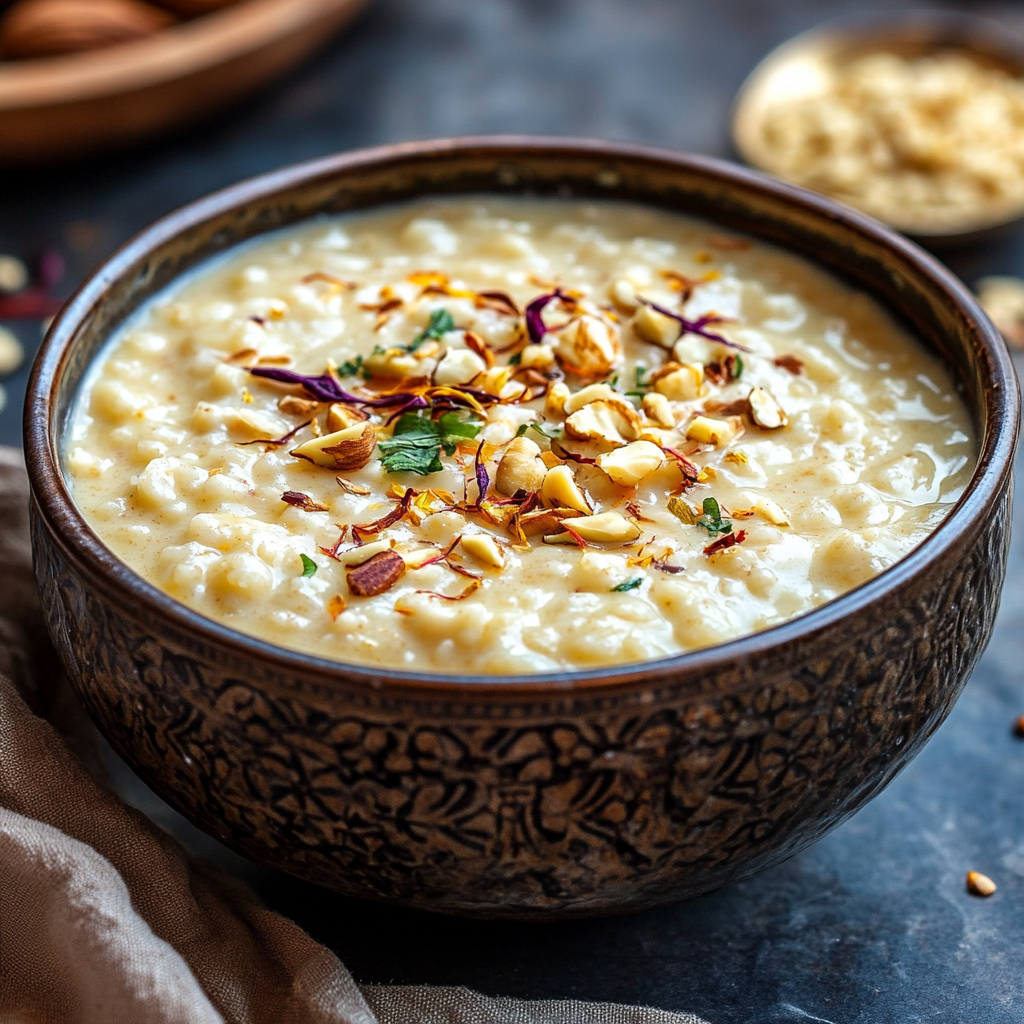Prep
10m
Cook
30m
Serves
6
Explore traditional Rice Kheer recipe. This Indian rice pudding recipe, made with basmati rice, milk, and flavored with cardamom and saffron, is simple to prepare and ideal for any occasions.
Ingredients (6)
1/4 cup basmati rice
1 cup water
4 cups full-fat milk
1/2 cup sugar (adjust to taste)
1/4 teaspoon cardamom powder
Chopped nuts (such as almonds, pistachios, or cashews) for garnish
A few strands of saffron (optional)
Steps (5)
Cook Rice
Rinse the Rice: Start by rinsing the basmati rice under cold water until the water runs clear. This removes excess starch and prevents the pudding from becoming too sticky.
Cook the Rice: In a pot, combine the rinsed rice and 1 cup of water. Bring it to a boil over medium heat.
Simmer: Once boiling, reduce the heat to low, cover the pot, and let it simmer until the rice is soft and the water is absorbed, about 15-20 minutes. If needed, you can add a little more water to ensure the rice cooks fully.
Add Milk
Incorporate Milk: Once the rice is cooked, add 4 cups of full-fat milk to the pot. Stir gently to combine.
Bring to a Boil: Increase the heat and bring the mixture to a gentle boil. Keep an eye on it to prevent the milk from overflowing.
Simmer
Reduce Heat: Once boiling, reduce the heat to low. Let the mixture simmer uncovered for about 20 minutes.
Stir Occasionally: Stir occasionally to prevent the milk from sticking to the bottom of the pot. You’ll notice the mixture thickening as it cooks.
Add Sugar and Spices
Sweeten the Kheer: After simmering, add 1/2 cup of sugar to the pot. Stir well to dissolve the sugar completely.
Flavor with Cardamom: Sprinkle in 1/4 teaspoon of cardamom powder and mix well. If you’re using saffron, soak a few strands in a tablespoon of warm milk and add it to the kheer for extra flavor and color.
Final Simmer: Let the kheer simmer for another 5-10 minutes, stirring gently. Taste and adjust the sweetness if necessary.
Garnish and Serve
Prepare the Garnish: Chop your choice of nuts, such as almonds, pistachios, or cashews. You can toast them lightly in a dry pan for added flavor.
Serve: Pour the kheer into serving bowls. Garnish generously with chopped nuts.
Temperature: You can serve the kheer warm, at room temperature, or chilled, depending on your preference.

Additional tips
- Storage: Leftover kheer can be stored in the refrigerator for up to 3 days. Just reheat gently before serving.
- Variations: Feel free to add dried fruits like raisins or figs during the cooking process for added sweetness and texture.
- Consistency: Adjust the consistency of the kheer by adding more milk if you prefer it creamier.
Table of Contents
The Ultimate Guide to Indian Rice Pudding: History, Benefits, and Accompaniments of the Indian Rice Pudding Recipe
Introduction
The Indian Rice Pudding Recipe, commonly known as kheer, is a delectable dessert that has found its way into hearts and homes around the world. This creamy, sweet treat is not just a dish; it embodies tradition, culture, and comfort. In this ultimate guide, we’ll delve into the historical roots of this beloved dessert, explore its numerous benefits, and suggest delightful accompaniments to elevate your Indian Rice Pudding Recipe experience.
The Historical Context of Indian Rice Pudding
Ancient Beginnings
The origins of the Indian Rice Pudding Recipe can be traced back thousands of years. Ancient texts suggest that rice pudding was a part of culinary traditions during the Vedic period in India. It was often prepared during religious ceremonies, symbolizing prosperity and abundance. The earliest mentions of kheer indicate that it was not only a treat but also a sacred offering to the deities.
Evolution Over Time
As time progressed, various regions in India developed their unique takes on the Indian Rice Pudding Recipe. From the creamy varieties of North India, often flavored with cardamom and garnished with nuts, to the South Indian versions that might incorporate coconut milk and jaggery, each regional adaptation tells a story of local ingredients and culinary practices.
Cultural Significance
The Indian Rice Pudding Recipe holds a place of honor during festivals and celebrations. It is an integral part of festivities like Diwali, Eid, and various weddings. This dessert not only satisfies the sweet tooth but also signifies the joy and togetherness that accompany these special occasions.
Nutritional Benefits of Indian Rice Pudding
1. A Nutrient Powerhouse
The Indian Rice Pudding Recipe is not only delicious but also offers a variety of health benefits. It is rich in calcium due to its primary ingredient, milk. This essential nutrient plays a crucial role in maintaining strong bones and teeth, making it a healthy treat for all ages.
2. Energy Booster
Rice is a great source of carbohydrates, providing the body with the energy it needs. The Indian Rice Pudding Recipe is particularly beneficial for children and active individuals who require sustained energy throughout the day.
3. Antioxidant Properties
Many traditional recipes include spices such as saffron and cardamom, which are known for their antioxidant properties. These spices not only enhance the flavor of the Indian Rice Pudding Recipe but also contribute to overall health by reducing oxidative stress in the body.
4. Digestive Health
The ingredients in the Indian Rice Pudding Recipe can promote digestive health. Rice is easy to digest, making kheer a suitable dessert for those with sensitive stomachs. Additionally, variations that include nuts and seeds can provide dietary fiber, supporting a healthy digestive system.
Cultural Significance of Indian Rice Pudding
Festivals and Celebrations
The Indian Rice Pudding Recipe is synonymous with celebration. During major festivals, kheer takes center stage, often prepared as an offering during religious rituals. Sharing this dessert during family gatherings strengthens bonds and creates lasting memories.
Family Traditions
Each family often has its cherished version of the Indian Rice Pudding Recipe, passed down through generations. This not only preserves family traditions but also allows for creativity and personal touch in every preparation. The stories shared over a bowl of kheer become part of the family lore, enhancing its significance.
How to Perfect Your Indian Rice Pudding Recipe
Choosing the Right Ingredients
The key to a delicious Indian Rice Pudding Recipe lies in selecting high-quality ingredients. Opt for basmati or jasmine rice for a fragrant and flavorful base. Whole milk is preferred for its creaminess, but alternatives like almond or coconut milk can also be used for a dairy-free version.
Cooking Techniques
Cooking the Indian Rice Pudding Recipe involves slow simmering, which allows the flavors to meld beautifully. Stirring occasionally ensures that the rice cooks evenly and prevents it from sticking to the bottom of the pot. Patience is crucial, as the best kheer develops a rich, creamy texture over time.
Flavor Variations
While traditional kheer features cardamom and saffron, you can experiment with different flavors. Adding rose water or khoya can give your Indian Rice Pudding Recipe a unique twist. Don’t hesitate to incorporate seasonal ingredients like mango or coconut for a fresh take.
Perfect Accompaniments for Indian Rice Pudding
1. Fresh Fruits
Pairing your Indian Rice Pudding Recipe with fresh fruits adds a refreshing contrast. Mango, strawberries, or even pomegranate seeds can enhance the dessert’s flavor and provide a colorful presentation.
2. Nuts and Dry Fruits
Nuts are a traditional garnish for kheer, adding both flavor and texture. Chopped almonds, pistachios, and cashews can be sprinkled on top. Dried fruits like raisins or figs can introduce a chewy element that complements the creaminess of the pudding.
3. Saffron Milk
For a luxurious touch, serve your Indian Rice Pudding with a drizzle of saffron-infused milk. This not only enhances the visual appeal but also adds a rich layer of flavor that makes your dessert even more indulgent.
4. Coconut Garnish
Incorporating shredded coconut as a garnish can add a tropical twist to your Indian Rice Pudding Recipe. This ingredient enhances the flavor profile and introduces a delightful texture contrast.
5. Spiced Whipped Cream
Consider serving your kheer with a dollop of whipped cream flavored with cardamom or cinnamon. This light addition can beautifully balance the richness of the pudding, making it a perfect finishing touch.
Regional Variations of Indian Rice Pudding
North Indian Kheer
In Northern India, the Indian Rice Pudding Recipe is typically made with full-fat milk and is often flavored with cardamom and garnished with nuts. The use of khoya (reduced milk) is common, adding a rich depth of flavor.
South Indian Payasam
In South India, a variation called payasam is popular. It often uses jaggery instead of sugar and may include coconut milk, giving it a distinct sweetness and flavor profile. This version often features ingredients like banana or sago, making it unique.
Bengali Kheer
Bengali cuisine presents another take on the Indian Rice Pudding Recipe. In West Bengal, kheer might be made with a special variety of rice called gobindo bhog, which imparts a unique aroma and taste. It’s often enriched with grated coconut, adding a delightful texture.
Conclusion
The Indian Rice Pudding Recipe is a culinary gem that offers a blend of history, culture, and nutritional benefits. Whether enjoyed during festivals or as a comforting dessert at home, kheer represents the richness of Indian culinary traditions. Its versatility allows for endless variations, making it a favorite across diverse communities.
As you embark on your journey to create the perfect Indian Rice Pudding Recipe, remember to embrace the flavors, stories, and traditions that accompany it. Whether served plain or adorned with fruits, nuts, and spices, your kheer will surely bring joy to those who share it with you.
In a world where food is a reflection of culture and tradition, the Indian Rice Pudding Recipe stands as a delicious testament to the beauty of shared culinary heritage. Enjoy crafting this timeless dessert, and may it inspire stories and connections for years to come.

